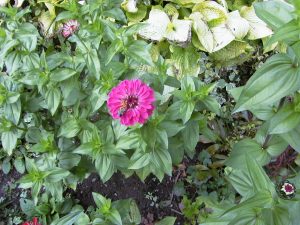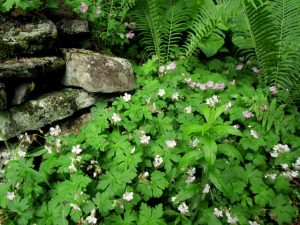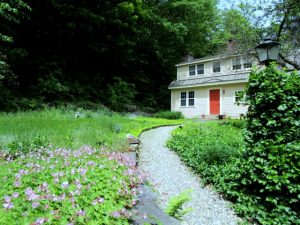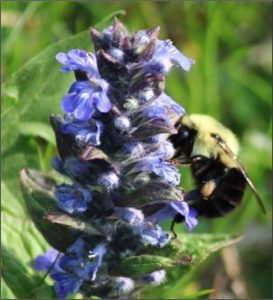 Last month I began a noble experiment on the grounds surrounding the little house on the hill to test the findings of a study done by the USDA and partners funded by the National Science Foundation. Specifically, I wanted to know how mowing affected bee welfare in my yard.
Last month I began a noble experiment on the grounds surrounding the little house on the hill to test the findings of a study done by the USDA and partners funded by the National Science Foundation. Specifically, I wanted to know how mowing affected bee welfare in my yard.
Briefly, the researchers want to determine how lawn-mowing patterns affected bee welfare in suburbia. To do this, they mowed 16 single-family, owner-occupied yards in a residential area of Springfield, Massachusetts. The chosen sites weren’t treated with herbicides or irrigated. None had vegetable or pollinator gardens; any hedges or cultivated flowers present were limited. The researchers recorded all flower species and their locations in the yard. These included those that that grew voluntarily in the lawns. The researchers also provided a professional mowing service throughout the study to ensure that all test lawns were mowed the same height with same kind of mower. In other words, they did everything in their power to make the lawns in the study as similar as possible.
During the experiment, the lawns were mowed at 1, 2, and 3-week intervals and the researchers measured the number and diversity of the bee populations in the study locations. During ten sampling rounds, they collected a total of 4587 bees belonging to 93 different species. Surveys of lawns mowed weekly had 1425 bees representing 72 species. Those mowed every two weeks had 1903 bees representing 60 species, and those mowed every three weeks had 1259 bees representing 62 species. The researchers did a lot of data analysis and concluded that mowing every two weeks yielded the most beneficial results for the bees.
From my perspective, what I needed to do as a nature lover was a no-brainer. I needed to try this on my own lawn which, on the average, met the criteria. From the beginning I had no desire to collect reproducible data; I just wanted to help the bees. I didn’t live in suburbia, lived about 100 miles north of Springfield, MA, and did have a few cultivated flower beds. But aside from the fact that I rarely had time to cultivate the latter and their composition included flowers that some people called weeds, I decided this would only help the bee population. Also, to maintain a semblance of consistency, I’d only weed those beds the weeks when I mowed the lawn.
(To illustrate this point, I’ve included pictures of flowers in my “gardens” that some people would call weeds. Some of these were here before the lawn–such as  it is–was. I just grouped them together to create the illusion of some sort of order. Others arose from seeds presumably carried by the wind, or on the fur, feathers, or in the stool or droppings deposited by some critter passing through or flying by. All photos were taken on Day 10 sans mowing or weeding this part of the yard.)
it is–was. I just grouped them together to create the illusion of some sort of order. Others arose from seeds presumably carried by the wind, or on the fur, feathers, or in the stool or droppings deposited by some critter passing through or flying by. All photos were taken on Day 10 sans mowing or weeding this part of the yard.)
I found no mention in the study of two factors I need to address up-front. One was the Anal Factor. For as long as I’ve lived here, I’ve been grateful for anything green that grew in the area devoted to lawn. As long as it looked uniformly green when I mowed it, I considered it evidence of genetic diversity, always a good thing in an area where the increased rate of climate change isn’t easy to deny. But after two weeks without mowing, I knew the average early summer lawn would look like hell and it would bother me a lot. To deal with this, I divided the lawn into 2 segments: one I could see from the front of house and another I could see from the back of it. This enabled me to find a location when a portion of lawn I saw met my neatness standard.
This lawn division also addressed factor two, the What Will the Neighbors Think factor. I owe this factor to growing up in a suburb of Pittsburgh, PA where everyone knew what everyone else was doing. This concern persists even though I now live alone on 6 acres. Or maybe it explains why I live on 6 acres. However while I enjoy my privacy, I’m not a recluse. I prefer to think of myself as more socially discriminating. But because some folks expect those like me in our mature prime to drop like rocks at any moment, I know that some who know me will check for signs of lawn neglect as they pass by on the road below the house. Fortunately, their view is limited to the lawn on the side of the house and that by the garage by the road. Mowing these on alternate weeks provides evidence that, though I might be slowing down, I haven’t died yet. So far no one has stopped to check on me so it must be working. Either that or word of my mowing sequence has leaked out somehow…
 During the first 2-week cycle, I marveled at a previously unnoticed population of tiny plants with tiny flowers that inhabit my lawn and all different kinds of bees and other insects that feed on them. These included many tiny ones I’d never noticed, even little butterflies! The biologist in me had no trouble whatsoever justifying the new mowing schedule based this alone. The decreased air and noise pollution that went with the reduced mowing was an added bonus. From that perspective, the 2-week interval was a no-brainer.
During the first 2-week cycle, I marveled at a previously unnoticed population of tiny plants with tiny flowers that inhabit my lawn and all different kinds of bees and other insects that feed on them. These included many tiny ones I’d never noticed, even little butterflies! The biologist in me had no trouble whatsoever justifying the new mowing schedule based this alone. The decreased air and noise pollution that went with the reduced mowing was an added bonus. From that perspective, the 2-week interval was a no-brainer.
Images of a possible condensed mini-crop rotation phenomenon filled my head as I mowed. Would the insects flee to the safe lawn area when they sensed the mower approaching? How would this effect the plant and insect life in both areas? Would they adapt to make the most of both areas? Although I’ve yet to come anywhere close to answering these questions, just thinking about them makes the mowing more enjoyable.
But like a recovering alcoholic or drug-abuser I needed—and still need—to constantly remain on guard for sneak attacks by the devious Anal and What Will the Neighbors Think factors. Instead of casually glancing at the long-range weather forecast and then promptly forgetting it as usual, sometimes I find myself zeroing in on the designated mowing date. Despite knowing weather data is highly unreliable 14-days in advance, if I see raindrops in the designated mowing day icon, I’ll began to fret. If I see rain icons for the days preceding and following it too, I veer toward depression. Totally irrational behavior and, worse, I know it when I do it. This area routinely experiences intervals in the spring and early summer when prolonged rainy spells make mowing impossible, I remind myself. And when these occurred in the past, I didn’t give them a second thought. There always are more than enough inside chores to do when I can’t work outdoors.
Or fueled by a seemingly endless stream of media reports, I’ll look at my shaggy lawn and, instead of seeing the diversity of plant and animal wildlife it sustains, I see a seething mass of pathogen-laden ticks. This fantasy far exceeds the irrational scale because tick-prevention heads the list when mowing grass of any height.
Fortunately with each mowing cycle, my concerns recede faster and seeing this as the new norm grows easier. Now when I mow I even can envision a time when the plant and animal wildlife that survive thanks to the prolonged cycle will adapt to it. If so, my lawn and I could have the best of both possible worlds.

Credit: USDA Forest Service
Briefly, the researchers want to determine how lawn-mowing patterns affected bee welfare in suburbia. To do this, they mowed 16 single-family, owner-occupied yards in a residential area of Springfield, Massachusetts. The chosen sites weren’t treated with herbicides or irrigated. None had vegetable or pollinator gardens; any hedges or cultivated flowers present were limited. The researchers recorded all flower species and their locations in the yard. These included those that that grew voluntarily in the lawns. The researchers also provided a professional mowing service throughout the study to ensure that all test lawns were mowed the same height with same kind of mower. In other words, they did everything in their power to make the lawns in the study as similar as possible.
During the experiment, the lawns were mowed at 1, 2, and 3-week intervals and the researchers measured the number and diversity of the bee populations in the study locations. During ten sampling rounds, they collected a total of 4587 bees belonging to 93 different species. Surveys of lawns mowed weekly had 1425 bees representing 72 species. Those mowed every two weeks had 1903 bees representing 60 species, and those mowed every three weeks had 1259 bees representing 62 species. The researchers did a lot of data analysis and concluded that mowing every two weeks yielded the most beneficial results for the bees.
From my perspective, what I needed to do as a nature lover was a no-brainer. I needed to try this on my own lawn which, on the average, met the criteria. From the beginning I had no desire to collect reproducible data; I just wanted to help the bees. I didn’t live in suburbia, lived about 100 miles north of Springfield, MA, and did have a few cultivated flower beds. But aside from the fact that I rarely had time to cultivate the latter and their composition included flowers that some people called weeds, I decided this would only help the bee population. Also, to maintain a semblance of consistency, I’d only weed those beds the weeks when I mowed the lawn.
(To illustrate this point, I’ve included pictures of flowers in my “gardens” that some people would call weeds. Some of these were here before the lawn–such as it is–was. I just grouped them together to create the illusion of some sort of order. Others arose from seeds presumably carried by the wind, or on the fur, feathers, or in the stool or droppings deposited by some critter passing through or flying by. All photos were taken on Day 10 sans mowing or weeding this part of the yard.)
it is–was. I just grouped them together to create the illusion of some sort of order. Others arose from seeds presumably carried by the wind, or on the fur, feathers, or in the stool or droppings deposited by some critter passing through or flying by. All photos were taken on Day 10 sans mowing or weeding this part of the yard.)
I found no mention in the study of two factors I need to address up-front. One was the Anal Factor. For as long as I’ve lived here, I’ve been grateful for anything green that grew in the area devoted to lawn. As long as it looked uniformly green when I mowed it, I considered it evidence of genetic diversity, always a good thing in an area where the increased rate of climate change isn’t easy to deny. But after two weeks without mowing, I knew the average early summer lawn would look like hell and it would bother me a lot. To deal with this, I divided the lawn into 2 segments: one I could see from the front of house and another I could see from the back of it. This enabled me to find a location when a portion of lawn I saw met my neatness standard.
This lawn division also addressed factor two, the What Will the Neighbors Think factor. I owe this factor to growing up in a suburb of Pittsburgh, PA where everyone knew what everyone else was doing. This concern persists even though I now live alone on 6 acres. Or maybe it explains why I live on 6 acres. However while I enjoy my privacy, I’m not a recluse. I prefer to think of myself as more socially discriminating. But because some folks expect those like me in our mature prime to drop like rocks at any moment, I know that some who know me will check for signs of lawn neglect as they pass by on the road below the house. Fortunately, their view is limited to the lawn on the side of the house and that by the garage by the road. Mowing these on alternate weeks provides evidence that, though I might be slowing down, I haven’t died yet. So far no one has stopped to check on me so it must be working. Either that or word of my mowing sequence has leaked out somehow…
Images of a possible condensed mini-crop rotation phenomenon filled my head as I mowed. Would the insects flee to the safe lawn area when they sensed the mower approaching? How would this effect the plant and insect life in both areas? Would they adapt to make the most of both areas? Although I’ve yet to come anywhere close to answering these questions, just thinking about them makes the mowing more enjoyable.
But like a recovering alcoholic or drug-abuser I needed—and still need—to constantly remain on guard for sneak attacks by the devious Anal and What Will the Neighbors Think factors. Instead of casually glancing at the long-range weather forecast and then promptly forgetting it as usual, sometimes I find myself zeroing in on the designated mowing date. Despite knowing weather data is highly unreliable 14-days in advance, if I see raindrops in the designated mowing day icon, I’ll began to fret. If I see rain icons for the days preceding and following it too, I veer toward depression. Totally irrational behavior and, worse, I know it when I do it. This area routinely experiences intervals in the spring and early summer when prolonged rainy spells make mowing impossible, I remind myself. And when these occurred in the past, I didn’t give them a second thought. There always are more than enough inside chores to do when I can’t work outdoors.
Or fueled by a seemingly endless stream of media reports, I’ll look at my shaggy lawn and, instead of seeing the diversity of plant and animal wildlife it sustains, I see a seething mass of pathogen-laden ticks. This fantasy far exceeds the irrational scale because tick-prevention heads the list when mowing grass of any height.
Fortunately with each mowing cycle, my concerns recede faster and seeing this as the new norm grows easier. Now when I mow I even can envision a time when the plant and animal wildlife that survive thanks to the prolonged cycle will adapt to it. If so, my lawn and I could have the best of both possible worlds.
Credit: USDA Forest Service